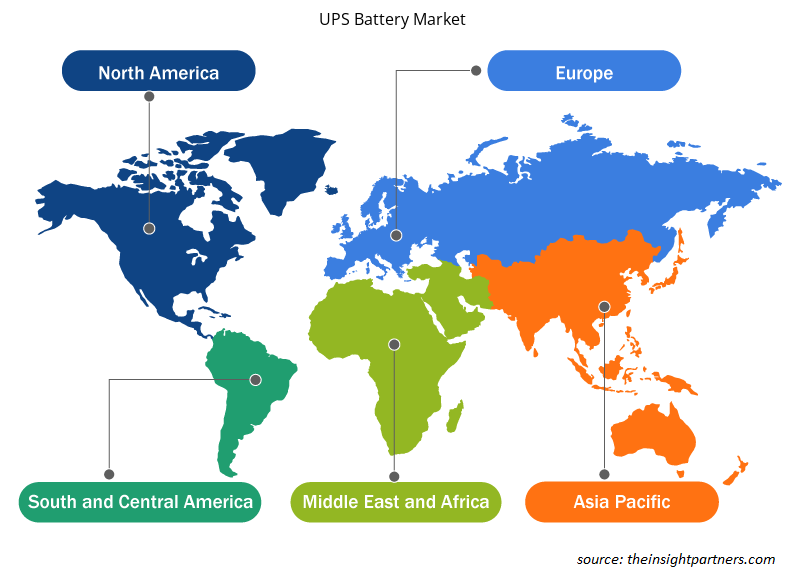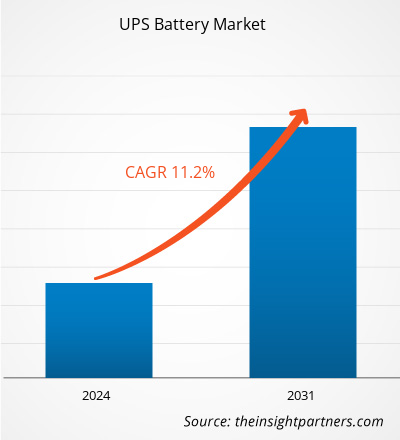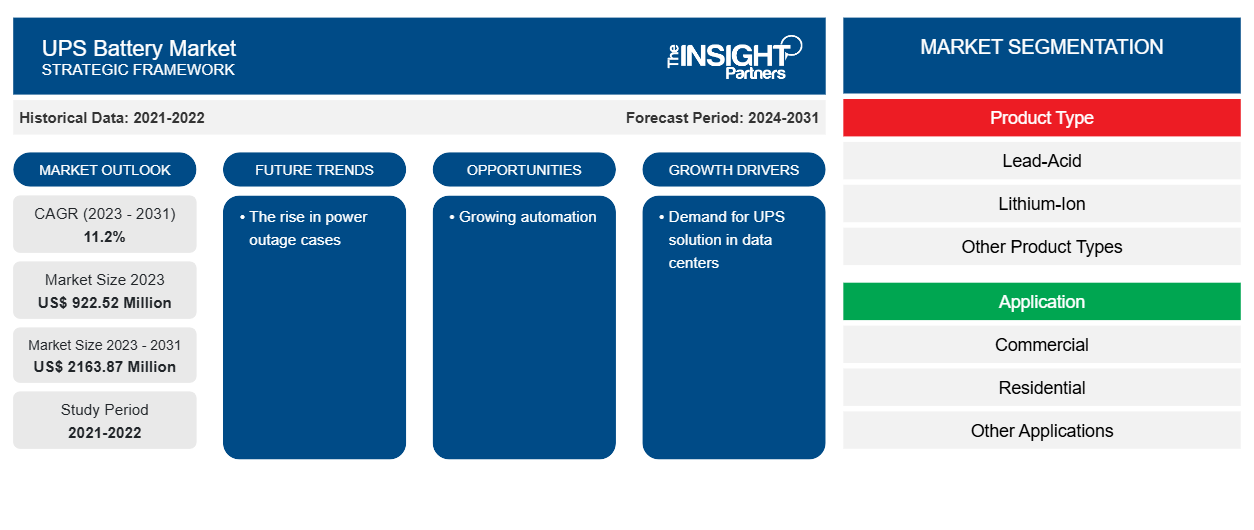Der Markt für USV-Batterien soll von 922,52 Millionen US-Dollar im Jahr 2023 auf 2163,87 Millionen US-Dollar im Jahr 2031 anwachsen. Der Markt wird zwischen 2023 und 2031 voraussichtlich eine durchschnittliche jährliche Wachstumsrate (CAGR) von 11,2 % verzeichnen. Die Zunahme von Stromausfällen und der wachsende Wohn- und Gewerbesektor dürften weiterhin wichtige Trends auf dem Markt bleiben.
Marktanalyse für USV-Batterien
Der zunehmende Bau großer Rechenzentren im Unternehmens- und Industriesektor erzeugt die Nachfrage nach USV-Systemen, was den USV-Batteriemarkt weiter antreibt. Der Bedarf an kontinuierlicher Stromversorgung für unternehmenskritische Elektronik, Einrichtungen, Geräte, kritische Infrastruktur und mehr treibt das Marktwachstum weiter voran. Die Zunahme von Stromausfällen auf der ganzen Welt erfordert weitere USV-Lösungen, was das Wachstum des USV-Batteriemarktes weiter vorantreibt.
Marktübersicht für USV-Batterien
Eine unterbrechungsfreie Stromversorgung (USV) oder USV-Stromquelle ist eine Art Stromversorgungssystem, das als Stromspeicher oder Backup bei Stromausfällen oder Stromausfällen fungiert. Es wird häufig zum Schutz von Hardware wie Rechenzentren, Computern, Telekommunikationsgeräten oder anderen elektrischen Geräten verwendet, bei denen eine unerwartete Stromunterbrechung Verletzungen, Todesfälle, schwerwiegende Betriebsunterbrechungen oder Datenverluste verursachen könnte. Der Anstieg von Rechenzentren und dem Industriesektor treibt das Marktwachstum von USV-Batterien voran.
Passen Sie diesen Bericht Ihren Anforderungen an
Sie erhalten kostenlose Anpassungen an jedem Bericht, einschließlich Teilen dieses Berichts oder einer Analyse auf Länderebene, eines Excel-Datenpakets sowie tolle Angebote und Rabatte für Start-ups und Universitäten.
-
Holen Sie sich die wichtigsten Markttrends aus diesem Bericht.Dieses KOSTENLOSE Beispiel umfasst eine Datenanalyse von Markttrends bis hin zu Schätzungen und Prognosen.
Treiber und Chancen auf dem USV-Batteriemarkt
Nachfrage nach USV-Lösungen in Rechenzentren
Die USV-Lösung ist ein entscheidendes System für unternehmenskritische Rechenzentrumsinfrastrukturen. Das Vorhandensein eines USV-Systems sorgt für eine konstante und effiziente Stromversorgung in den Rechenzentren . Es unterstützt das große Rechenzentrum, wenn die primäre Stromquelle ausfällt. Die Benutzer benötigen höhere Verfügbarkeitsgrade. Dieser Faktor erzeugt den Bedarf an mehr Strom für den effizienten Betrieb des Rechenzentrums. USV-Systeme im Rechenzentrum liefern innerhalb von Millisekunden nach einem Stromausfall die genaue Menge an Strom. Somit fördert der wachsende Rechenzentrumsmarkt das Wachstum des USV-Batteriemarktes.
Breiter Endverbraucher von USV-Batterien
Zu den wichtigsten Endverbrauchern des USV-Batteriemarktes zählen der gewerbliche, private und industrielle Sektor. Lebensmittel und Getränke, Pharmazeutik, Kraftwerke sowie die Luft- und Raumfahrt sind einige der wichtigsten Branchen, in denen es häufig zu Stromausfällen und sehr hohen Umgebungstemperaturen kommt. Da USV-Batterien eine Schlüsselkomponente der USV sind, sind sie für die gute Leistung und lange Lebensdauer der USV verantwortlich. Neben ihrer Verwendung sind Rechenzentren, Unternehmen, Haushaltsgeräte und Elektrogeräte weitere Anwendungsgebiete von USVs. Mit der zunehmenden Verbreitung von USVs wird sich der Anwendungsbereich von USV-Batterien erweitern.
Segmentierungsanalyse des USV-Batteriemarktberichts
Wichtige Segmente, die zur Ableitung der USV-Batteriemarktanalyse beigetragen haben, sind der Produkttyp und die Anwendung.
- Basierend auf dem Produkttyp ist der USV-Batteriemarkt in Blei-Säure-, Lithium-Ionen- und andere Produkttypen unterteilt. Das Lithium-Ionen-Segment wird voraussichtlich mit der höchsten CAGR wachsen.
- Nach Anwendung ist der Markt in gewerbliche, private und andere Anwendungen unterteilt. Das gewerbliche Segment hielt im Jahr 2023 einen erheblichen Marktanteil.
Marktanteilsanalyse für USV-Batterien nach geografischer Lage
Der geografische Umfang des USV-Batteriemarktberichts ist hauptsächlich in fünf Regionen unterteilt: Nordamerika, Asien-Pazifik, Europa, Naher Osten und Afrika sowie Süd- und Mittelamerika.
Der asiatisch-pazifische Raum hatte 2023 den größten Marktanteil. Der Anstieg beim Bau von Rechenzentren erzeugt die Nachfrage nach unterbrechungsfreier Stromversorgung, was das Wachstum des USV-Batteriemarktes in der Region vorantreibt. Die staatlichen Subventionen und die steigenden Investitionen der Marktteilnehmer in den Bau von Hyperscale-Rechenzentren treiben den Markt weiter an. Der Anstieg im Wohnsektor treibt das Marktwachstum an.
Regionale Einblicke in den USV-Batteriemarkt
Die regionalen Trends und Faktoren, die den USV-Batteriemarkt im Prognosezeitraum beeinflussen, wurden von den Analysten von Insight Partners ausführlich erläutert. In diesem Abschnitt werden auch die Marktsegmente und die Geografie des USV-Batteriemarkts in Nordamerika, Europa, im asiatisch-pazifischen Raum, im Nahen Osten und Afrika sowie in Süd- und Mittelamerika erörtert.

- Erhalten Sie regionale Daten zum USV-Batteriemarkt
Umfang des USV-Batteriemarktberichts
| Berichtsattribut | Details |
|---|---|
| Marktgröße im Jahr 2023 | 922,52 Millionen US-Dollar |
| Marktgröße bis 2031 | 2163,87 Millionen US-Dollar |
| Globale CAGR (2023 - 2031) | 11,2 % |
| Historische Daten | 2021-2022 |
| Prognosezeitraum | 2024–2031 |
| Abgedeckte Segmente |
Nach Produkttyp
|
| Abgedeckte Regionen und Länder |
Nordamerika
|
| Marktführer und wichtige Unternehmensprofile |
|
Marktteilnehmerdichte für USV-Batterien: Auswirkungen auf die Geschäftsdynamik verstehen
Der Markt für USV-Batterien wächst rasant. Dies wird durch die steigende Nachfrage der Endnutzer aufgrund von Faktoren wie sich entwickelnden Verbraucherpräferenzen, technologischen Fortschritten und einem größeren Bewusstsein für die Vorteile des Produkts vorangetrieben. Mit der steigenden Nachfrage erweitern Unternehmen ihr Angebot, entwickeln Innovationen, um die Bedürfnisse der Verbraucher zu erfüllen, und nutzen neue Trends, was das Marktwachstum weiter ankurbelt.
Die Marktteilnehmerdichte bezieht sich auf die Verteilung der Firmen oder Unternehmen, die in einem bestimmten Markt oder einer bestimmten Branche tätig sind. Sie gibt an, wie viele Wettbewerber (Marktteilnehmer) in einem bestimmten Marktraum im Verhältnis zu seiner Größe oder seinem gesamten Marktwert präsent sind.
Die wichtigsten auf dem USV-Batteriemarkt tätigen Unternehmen sind:
- CSB Batterie Co., Ltd.
- East Penn Fertigungsunternehmen
- Eaton Corporation plc
- Exide Industries Limited
- FIAMM Energy Technology SpA
- GS Yuasa International Ltd
Haftungsausschluss : Die oben aufgeführten Unternehmen sind nicht in einer bestimmten Reihenfolge aufgeführt.

- Überblick über die wichtigsten Akteure auf dem USV-Batteriemarkt
Neuigkeiten und aktuelle Entwicklungen zum USV-Batteriemarkt
Der USV-Batteriemarkt wird durch die Erfassung qualitativer und quantitativer Daten nach Primär- und Sekundärforschung bewertet, die wichtige Unternehmensveröffentlichungen, Verbandsdaten und Datenbanken umfasst. Nachfolgend sind einige der Entwicklungen auf dem USV-Batteriemarkt aufgeführt:
- C&D Technologies, ein weltweit führender Anbieter von Energiespeicherlösungen für unterbrechungsfreie Stromversorgung (USV) in der Rechenzentrumsbranche, hat seine Premium-VRLA-Batterie Pure Lead Max (PLM) vorgestellt. Die Pure Lead Max ist die langlebigste VRLA-Batterie für USV-Systeme im Sortiment von C&D und verfügt über eine branchenführende Garantie von acht Jahren. (Quelle: C&D Technologies, Pressemitteilung, März 2023)
- Eaton hat die weltweite Markteinführung der unterbrechungsfreien Stromversorgung (USV) 9PX mit Lithium-Ionen-Akkus angekündigt. Eatons neue USV baut auf seiner Führungsrolle bei der Bereitstellung innovativer Lithium-Ionen-Akkus für Notstromlösungen auf und bietet eine längere Akkulebensdauer und einen geringeren Platzbedarf als die USV-Technologie mit ventilgeregelten Blei-Säure-Akkus (VRLA). Damit ist sie ideal für verteilte „Edge“-Umgebungen und leichte Industrieanwendungen vom Gesundheitswesen bis zum Bildungswesen. (Quelle: Eaton, Pressemitteilung, Juli 2021)
Marktbericht zu USV-Batterien – Abdeckung und Ergebnisse
Der Bericht „Marktgröße und Prognose für USV-Batterien (2021–2031)“ bietet eine detaillierte Analyse des Marktes, die die folgenden Bereiche abdeckt:
- USV-Batteriemarktgröße und -prognose auf globaler, regionaler und Länderebene für alle wichtigen Marktsegmente, die im Rahmen des Berichts abgedeckt sind
- USV-Batteriemarkttrends sowie Marktdynamik wie Treiber, Einschränkungen und wichtige Chancen
- Detaillierte PEST/Porters Five Forces- und SWOT-Analyse
- Analyse des USV-Batteriemarkts mit wichtigen Markttrends, globalen und regionalen Rahmenbedingungen, wichtigen Akteuren, Vorschriften und aktuellen Marktentwicklungen
- Branchenlandschaft und Wettbewerbsanalyse, einschließlich Marktkonzentration, Heatmap-Analyse, prominenten Akteuren und aktuellen Entwicklungen für den USV-Batteriemarkt
- Detaillierte Firmenprofile
- Historische Analyse (2 Jahre), Basisjahr, Prognose (7 Jahre) mit CAGR
- PEST- und SWOT-Analyse
- Marktgröße Wert/Volumen – Global, Regional, Land
- Branchen- und Wettbewerbslandschaft
- Excel-Datensatz
Aktuelle Berichte
Verwandte Berichte
Erfahrungsberichte
Grund zum Kauf
- Fundierte Entscheidungsfindung
- Marktdynamik verstehen
- Wettbewerbsanalyse
- Kundeneinblicke
- Marktprognosen
- Risikominimierung
- Strategische Planung
- Investitionsbegründung
- Identifizierung neuer Märkte
- Verbesserung von Marketingstrategien
- Steigerung der Betriebseffizienz
- Anpassung an regulatorische Trends























 Kostenlose Probe anfordern für - USV-Batteriemarkt
Kostenlose Probe anfordern für - USV-Batteriemarkt